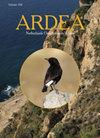稻田表型对伊比利亚半岛东部鹭群繁殖参数的影响
IF 1.3
4区 生物学
Q3 ORNITHOLOGY
引用次数: 2
摘要
稻田传统上被认为是包括苍鹭在内的许多水鸟的主要觅食地。研究表明,田间管理和洪水周期影响了这些鸟类的生殖参数。位于伊比利亚半岛东海岸的L'Albufera de valnncia拥有大面积的稻田,是西班牙第三大苍鹭繁殖地。自上次对蜂群进行评估(1990年)以来,发生的水和稻田管理的变化可能影响了蜂群的繁殖性能。对2015-2017年灰鹭、紫鹭、黄鹭、小白鹭、灰鹭(鹭科)、白鹭(斑鹭科)、灰鹭(斑鹭科)、灰鹭(斑鹭科)的窝卵数、窝卵数、孵化、筑巢和繁殖成功率进行了分析。2016年2月至2017年6月对稻田的洪水和种植程度进行了评估。生殖参数与稻田状态有关。所有生殖输出参数均低于文献报道。在2016年,产卵开始得更早(4月底),当时田地还很干燥,在洪水过后的5月开始孵化。在2017年,孵化高峰发生在6月,当时田地播种。除苍鹭外,其他品种的繁殖成功率与播种面积有显著关系。我们发现,在洪水发生日期附近开始产卵的鸟类,小白鹭、朱鹮、牛白鹭和紫鹭的繁殖成功率相对较高。在这种类型的人工湿地中,筑巢种群的成功需要水管理计划,使洪水制度和洪水地区的维护与这些物种的生物需求同步。本文章由计算机程序翻译,如有差异,请以英文原文为准。
Effects of Rice Field Phenology on Breeding Parameters of Heron Colonies in the East of the Iberian Peninsula
Rice fields have traditionally been considered key feeding grounds for many waterbird species, including herons. Studies show that field management and flooding cycles influence the reproductive parameters of these birds. L'Albufera de València, on the east coast of the Iberian Peninsula, has large areas of rice fields and is home to the third largest breeding colony of herons in Spain. Changes in water and rice field management that have occurred since the colony was last assessed (1990) may have affected the colony's reproductive performance. Clutch and brood size, and hatching, nesting and breeding success were estimated for Grey Heron Ardea cinerea, Purple Heron Ardea purpurea, Cattle Egret Bubulcus ibis, Little Egret Egretta garzetta, Squacco Heron Ardeola ralloides (Ardeidae) and Glossy Ibis Plegadis falcinellus (Threskiornithidae) in 2015–2017. The extent of flooding and cultivation of rice fields was assessed from February 2016 to June 2017. Reproductive parameters were related to the state of the rice fields. All reproductive output parameters were lower than those reported in the literature. In 2016, laying started earlier (at the end of April), when the fields were still dry and hatching started from May, after flooding. In 2017, peak hatching occurred in June, when the fields were sown. A significant relationship was found between breeding success and the area of sown fields, except for the Squacco Heron. We found that birds that initiated egg laying closer to the date of flooding had a relatively higher breeding success for the Little Egret, Glossy Ibis, Cattle Egret and Purple Heron. The success of nesting populations in this type of artificial wetland requires water management plans that synchronize flooding regimes and maintenance of flooded areas with the biological requirements of these species.
求助全文
通过发布文献求助,成功后即可免费获取论文全文。
去求助
来源期刊

Ardea
生物-鸟类学
CiteScore
2.10
自引率
0.00%
发文量
49
审稿时长
>12 weeks
期刊介绍:
Ardea is the scientific journal of the Netherlands Ornithologists'' Union, and is published since 1912. The journal welcomes manuscripts reporting significant new findings in ornithology, in particular those covering the ecology, life history, and evolution of birds, and including sound descriptive work. Ardea publishes Original research papers, Short notes and Book reviews. In addition to the regular three issues per year, Ardea publishes specials that contain conference or workshop proceedings (produced on request).
 求助内容:
求助内容: 应助结果提醒方式:
应助结果提醒方式:


